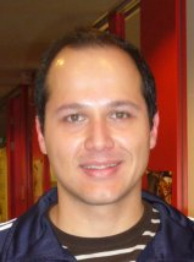Switching activation barriers: new insights in e-field driven processes at the interface
Perspectives in physical chemistry and catalysis
Promotion date: April 11th
Promotor: Prof.dr. Han Gardeniers and Prof.dr.ir. Leon Lefferts
Assistant Promotor: Dr. Arie van Houselt
| The design and fabrication of a microreactor using cleanroom techniques is described. The aim was to produce a microreactor which enables simultaneous application of an external electrical field and in situ spectroscopic investigations by Attenuated Total Internal Reflection Infrared Spectroscopy (ATR-IR). In order to optimize the electric field, special attention has been paid to the silicon microelectrodes. This microstructured electrode was used to guide the electric field. It turns out that this micro-structured surface possesses unique water and oil repelling properties, which were highlighted on the cover of Soft Matter. With the use of the same surfaces, it appears to be possible - by the evaporation of a colloidal suspension - to create crystalline spheres resembling soccer-balls. Careful attention was given to the microreactor configuration, both with regard to the electrical properties as to the spectroscopic properties. Spectroscopic investigation revealed that interstitial oxygen in the Si-lattice can be studied in this microreactor, while from the electrical characterization it is apparent that the electrical behavior of the microreactor with such a small gap is very complex. The thesis concludes with exploratory experiments showing CO adsorption and oxidation. |
Can you recall some important moments during your PhD period?
The integration of the ATR-microreactor was a very challenging one. This part of my work gave me the opportunity to collaborate with several colleagues from different disciplines in Physics, Materials Science and Chemistry.
After the fabrication of the microreactor, we realized several exploratory experiments where we have shown that the configuration of adsorbed molecules on a catalyst can be manipulated by the application of an E-field.
Did you have some nice articles published?
Besides the cover article in Soft Matter – which I published in corporation with Physics of Fluids - articles appeared in Journal of Physical Chemistry C, Journal of Micromechanics, and Microengineering and Proceedings of the National Academy of Science.
What are your future plans?
I am not sure about that yet. Before starting my PhD project, I was working for Johnson Controls for two years already. I like both academia and industry. In order to perform at my best, I will choose a goal-oriented project with an appealing content.
In what way did you perceive the Mesa+ research atmosphere?
It is a privileged feeling to collaborate with different groups, all bringing their own fields of expertise. This is one of the biggest Mesa+ strengths. I believe that the Mesa+ Institute provides great opportunities in both personal and global scale. The Institute is renowned for its high standard, scientific research and its facilities.

